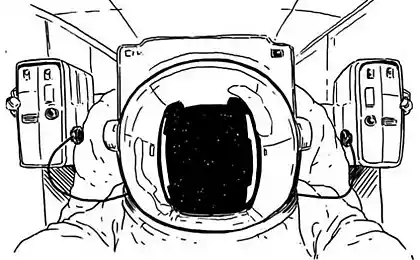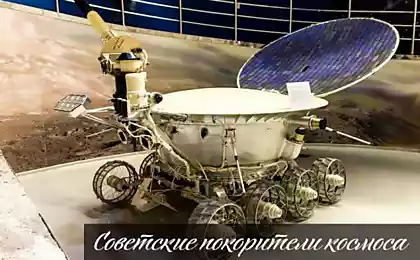661
Journey to Mars: what would happen to an astronaut on the way to the planet and on its surface

The new US President Donald trump, contrary to expectations, not cut NASA's budget. Overall, he left it as it is, by signing the paper on the allocation of funds planned by experts of Agency projects. One such project — flight to Mars and the landing of the first marsonautes. This must happen not later than 2033.
At that time, as some scientists develop reliable ways of delivering humans to Mars, others are studying the possible dangers that lie in wait for astronauts and colonists on the way to the goal. These dangers much as on the way to the planet and on its surface. A recent study conducted by experts of the Center for regenerative medicine, University of Wake Forestomach that among other problems, the astronauts lurks the threat of leukemia and low immunity.
The results of earlier studies indicate that the marsonautes threaten and even dementia with memory loss from ionizing radiation. What problems may face potential travelers to Mars?
For example, the flight might end, not really begun. For travel to Mars we need a powerful booster, which is unique. Developing it from scratch. Despite the fact that the rocket and each item is subjected to multiple inspection audits, troubles do happen. From the disasters of the recent history of Astronautics it is worth mentioning the explosion of the carrier rocket Falcon 9 due to an unexpected wall damage of a composite material, separating the fuel from oxidant. According to Elon musk, CEO of SpaceX, which developed the missile, the accident was triggered by a number of coincidences, series of failures of materials and equipment, analogues of which have not yet been. Well, in this case affected only the equipment, people on Board was not. Even more serious was the accident, the moon rocket of the USSR "N-1", all four of the trials were unsuccessful and were accompanied by victims.
What if unforeseen problems arose aboard a rocket traveling to the first in the history of mankind flight to Mars? Would the victim, extremely expensive rocket would have been destroyed and, most likely, on the exploration of Mars in the near future would be put bold cross.
Mission to Mars
Radiation
Well, the missile took off, no problems, people are sent to Mars. The path the planet takes around 9 months to one side, that is the real long-term space flight. And here man faces the radiation. The fact that a large part of ionizing radiation does not reach the Earth's surface due to the magnetic field of our planet and its atmosphere. The higher, the more the density of radiation. Perhaps it is because of the radiation cosmonaut Valentin Lebedev, who spent orbiting the Earth 221 day lost sight.
Experts compare the protection offered by the atmosphere from ionizing radiation, with a steel thickness of 1 meter. That is, such protection can only break the particles of highest energy. As for the ISS or a spacecraft, the protection is conditioned by the thickness of the shell, and it is, at best, a few centimeters. According to experts NASA, space radiation can lead to the development of Alzheimer's disease.
Some experts believe that women on Mars is better not to fly. "Since women in General live longer than men, according to the forecast of NASA, they have higher chance to get cancer in my life, being exposed to the same amount of radiation as men. The calculations have shown that women in General should not go to Mars, because the cumulative radiation exposure for the entire duration of the flight exceeds the maximum allowable 3% risk of developing cancer," says Dorit Donoval, Deputy Director of the National Institute for space biomedical research (NSBRI).
Microgravity
All the way to Mars people will be in the almost complete absence of gravity at least 9 months. But it is also health problems. People on Earth the body is adapted to normal gravity, and different systems of our body fighting it, trying to bring blood and other physiological fluids up. Immediately after exposure on the ISS (or a missile), these systems continue to operate, so that even the appearance of people changes somewhat. For example, due to intracranial pressure changes somewhat the form of the eyeballs.

Altered taste and smell, weakened muscles in the body, including the muscles of the heart. Much more complicated operation of the vestibular apparatus. Some people have no forces of attraction completely disappears or greatly weakened sense of taste and smell. Without exercise people lose around 20% muscle mass in just a few weeks.
Specialists also noted that the manifestation of the same effect as the space adaptation syndrome. When some people microgravity, lost appetite, there is headache, dizziness. Actually, we are talking about sea-sickness, which in this case is best described as "space".
The longer a person stays in space, the greater the loss of bone tissue. Due to the lack of the usual loads, the bones become lighter and brittle. Each month lost about 1.5% of the bone tissue. Yet it is unclear how serious this problem is and whether it is reversible. Of course, the ISS has exercise equipment, so the astronauts exercise, trying not to lose shape. But whether to put such equipment in a space ship that will go to Mars?
The spine also suffers increases the distance between the vertebrae, and the person feels pain. Astronauts solved the problem by pushing his hands and feet to the walls of the station, thus, the spine is compressed and a few minutes was enough to ease the pain.
Psychological problems
If several people locked in a confined space for a few months, you must have a problem. No, not necessarily it will be expressed in conflicts, but the human psyche is in such moments of suffering. Some people may feel constant fatigue, irritability, poor sleep. From-for violations of the usual circadian rhythm, noise units, and other factors people do not feel very comfortable. Some even have to take sleeping pills.
Another psychological issue is the isolation from the outside world. Communication with Earth would be but the signal with distance from the planet will begin to lag. In addition, the Mars travelers will be clearly understood that in case of any problems, nobody will come to their aid. People left to themselves, will no doubt, weighs heavily on the psyche.
Hygiene
The ISS people are unable to take baths or to wash in the shower. The same can be said of the spacecraft that will fly to Mars. Special pads and compounds that have a space travelers all along the way. Rarely have to change underwear and wash in General will have to forget that dirty clothes, you may be able to wash already on Mars. But, most of all, just dispose of the or otherwise.
Arrival at Mars
The descent
So, marsonavty who have been in the way of 9 months, overcame all challenges and arrived at Mars. There is a need landing on the planet. But everything is not as easy as it may seem. The problem mainly consists in the descent. The fact that the atmosphere of Mars is about 100 times less dense than Earth's atmosphere. Accordingly, during the descent you will need more resistance in order to not crash into the surface at full speed. Heavy objects are gaining great speed, so there are limitations in the mass, which can be a lump sum to deliver to Mars.
This, according to the employee NASA's Bret Drake, a ton (it weighs as much Curiosity). "How do we descend through the atmosphere, remains an important challenge. With the current methods of planting, we may omit to Mars only a metric ton. This is not enough to establish a colony, for the colony need more," said Drake.
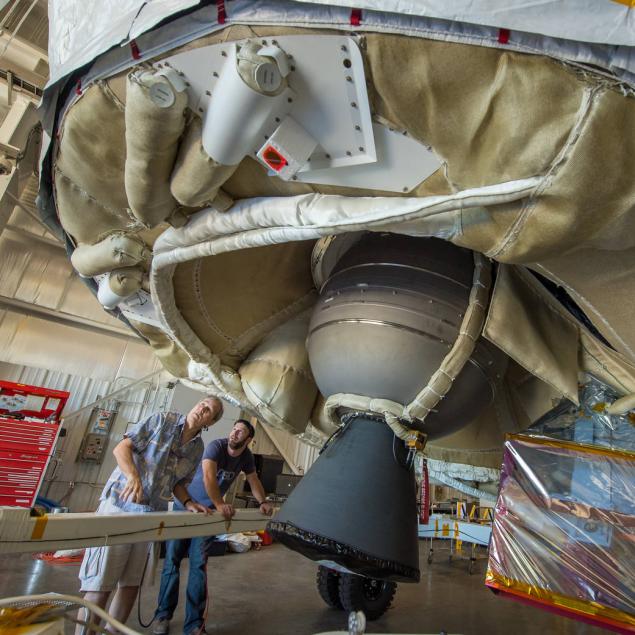
The developers of the Low-Density Supersonic Decelerator inspect the lower part of the system
He also says that, subject to the need to establish a colony on Mars in time will have to drop from 20 to 30 tons of cargo. Now NASA and various private companies, working on landing on Mars, trying to create a reliable way to drop people to the planet's surface. This may be disc-shaped apparatus Low-Density Supersonic Decelerator.
Cold and hunger
If everything turned out with the descent, it is worth remembering that the average temperature on Mars is minus 62 degrees Celsius. The temperature of the equator and gradually decreases towards the poles. A day on Mars may be hot and night very cold. ISS also faces the problem of significant temperature changes. So, the ISS is heated to 90 degrees Celsius, being exposed to the Sun and cooled down to -90 on the opposite side. Scientists and engineers have found a way out of this difficult situation, having achieved the creation of specialised systems of temperature control.
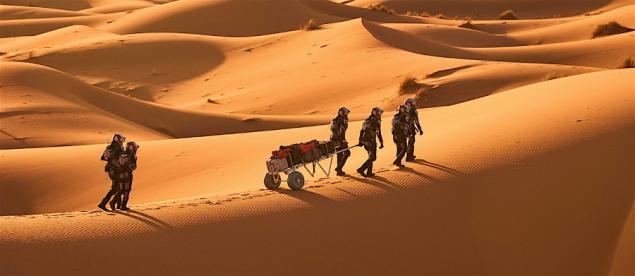
But the problem is that such systems are designed to work in vacuum. As for Mars, scientists are thinking of how to provide a comfortable existence to the marsonautes or colonists.
"We need a solution that will provide the best insulation in cold conditions and another method of heat dissipation in hot conditions. A spacesuit in a vacuum like a thermos, but a spacesuit on Mars will be more like a Cup of coffee on the kitchen table — a Cup of coffee cools down much faster compared to the coffee in the thermos," said Drake.
Food for people on Mars is also a problem. If we are talking about landing returning, you can do the usual astronaut food freeze dry. If we are talking about the colonists, you will have to grow food. How? While not completely clear, experts are still working on this issue. Some scientists believe that the Mars soil with the addition of some substances can be made suitable for growing crops.
In the second case, you will have to monitor the concentration of oxygen emitted by plants, in the atmosphere of the room where the colonists live. Too much oxygen is the probability of spontaneous explosions, or even the departure of the crew.
And again radiation
Experts from the Department of radiation Oncology at the University of California conducted a study to test how ionizing radiation will act on astronauts on Mars. As it turned out, after 12-24 weeks after exposure to weak doses of ionizing radiation (5 or 30 doses 48Ti or 16O) in experimental animals signs of cognitive dysfunction. The issue is with the change having dendrite structure, the change in the level of protein in neurotransmission and inflammation of the nervous tissue. The problem identified in animals; possibly, a similar problem will appear. There is a risk that due to the decline of cognitive functions in humans under the influence of ionizing radiation people just can not cope with the management of trusted systems that are not performing scientific and engineering tasks, or even forgetting about what you need to do.
Another manifestation of the effects of radiation is a fairly high probability of occurrence in people with leukemia and immunosuppression. The reason — all the same the radiation. Problem was identified by scientists of the Center for regenerative medicine at Wake forest University. They transplanted human stem cells into mice and subjected animals to the action of weak ionizing radiation. We are talking about special type of cells called hemocytoblasts. These cells give rise to all other blood cells. Hematopoietic stem cells located in red bone marrow, which, in turn, are located inside the cavities of most bones.
In this study, we studied genetically healthy adults 30-55 years. As it turned out, under the influence of radiation the ability of these cells to produce all types of blood cells decreased by 60-80%. In addition, the radiation led to mutations in genes involved in the hematopoietic process, which led to a decrease in the ability of hemocytoblasts to produce Mature blood cells.
The next step was checking the cells exposed to radiation. As it turned out, transplant them into mice last began to get sick with leukemia. Scientists believe that this could be evidence that space radiation can cause leukemia in humans.
Together with the already mentioned decrease in immunity with long-term human presence in microgravity will have a negative impact on the successful outcome of the expedition to Mars of any kind — at least a temporary landing astronauts, even though the arrival to the planet of the colonists.
And it should not be forgotten that in the first case, people will have to come back to Earth, which will lead to the re-effects of radiation, microgravity and other problems described previously. Plus, professionals need to find a reliable method of takeoff from Mars ' surface for return to Earth.
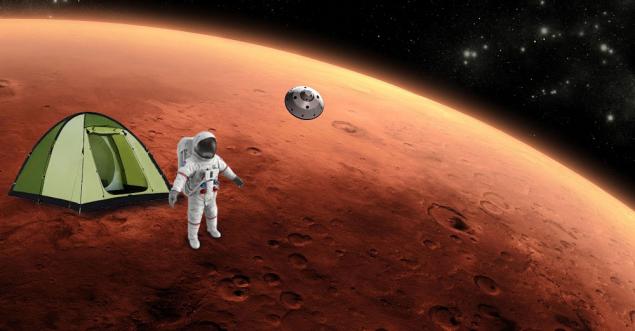
Anyway, the experts have not lost hope on the development of reliable security measures that can protect people from some dangers and to reduce the negative influence of others. That scientists and engineers believe in the successful outcome of the trip can speak and planned NASA manned mission to Mars by 2033 and Elon musk plans on the same flight and create a neighboring planet colony.
Source: geektimes.ru/post/287358/









